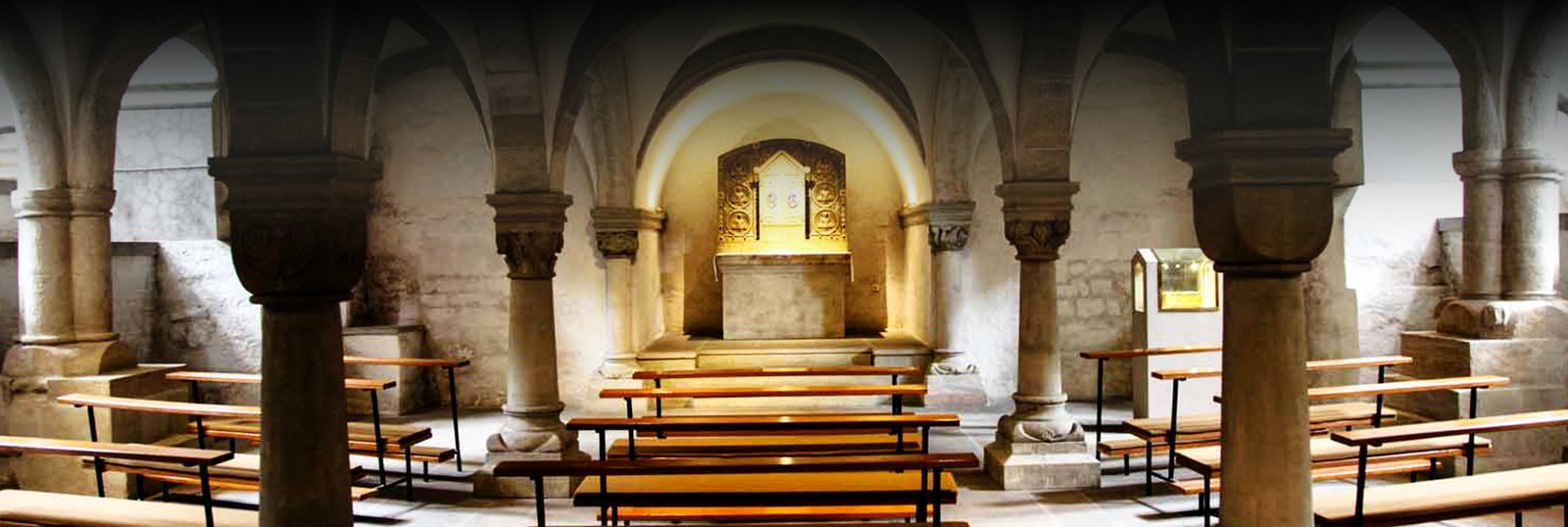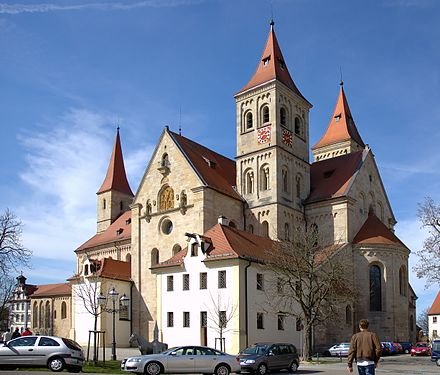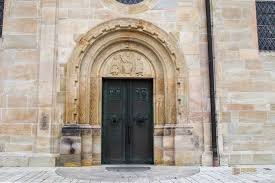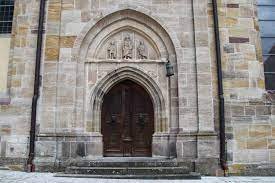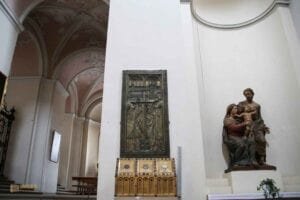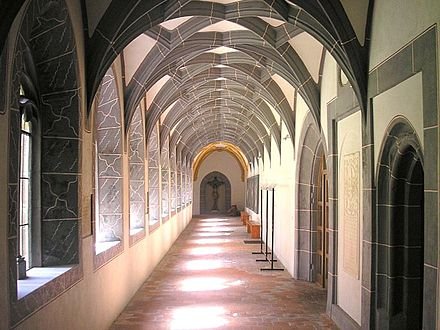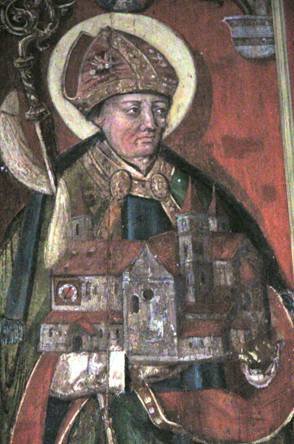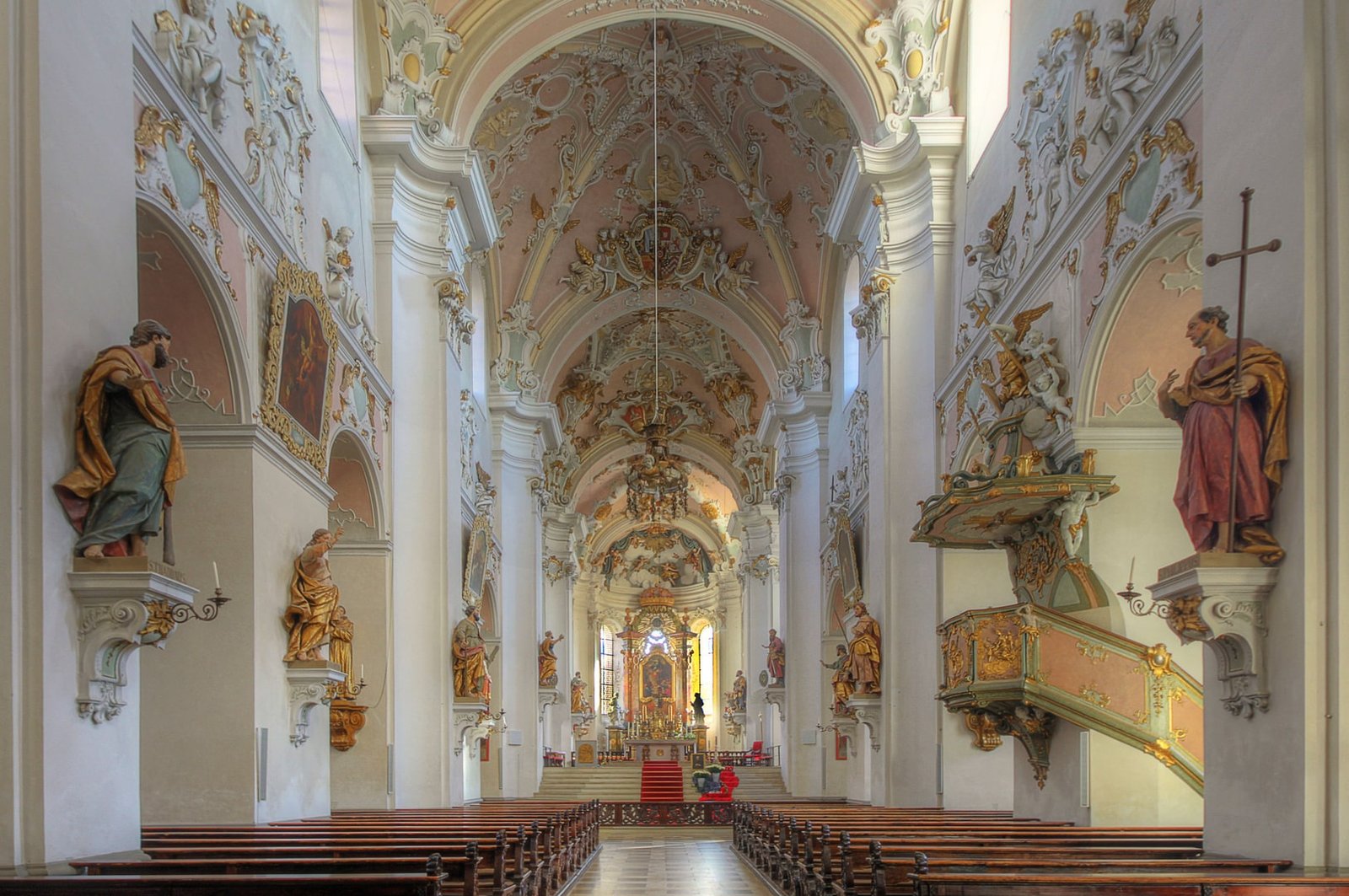Saint Vitus Monastery of Ellwangen
per person
The town of Ellwangen, belonging to the province of Badem-Würrtemberg in the south of Germany, is situated mostly on the eastern bank of the river Jagst, which in turn flows through the manifold forested hills of the broader ‚Schwäbisch-Fränkische Waldberge‘. Though in modern days, the Jagst‘s course has been straightened to the demands of civilization and the forests have receded out of the valleys, in the time of the foundation of the monastery of St. Vitus, the primaeval old-growth forest resembled a hostile wilderness. Situated just north of the old roman Limes, the area was just sparsely populated and according to the Vita Hariolfi, the then so-called ‚Virngrundwald‘ was even roamed by elks. As such, one of the founders, the nobleman Hariolf, was led into the Virngrundwald chasing an elk. The hunt having been successfully concluded, Hariolf pitched camp for the night and as he was just about to fall asleep, he heard the sound of church bells ringing. Following, he fell asleep thrice and heard the bells just as often. The Vita elaborates how –in face of this miracle – Hariolf found himself converted and longing to commit his life to God. He interpreted the event as presaging the flocks of monks that would soon arrive. And indeed, the chapel that was founded just on that spot – which is probably to be identified with the southern transept of the Basilika of St. Vitius – quickly grew into a sprawling monastery, partly due to its beneficial positioning near two important trade roads to the manifold landed gifts from the new novices.
The first monks probably flocked to Ellwangen from Burgundy. At least the first reliquaries were transferred from the Burgundian abbey of Saint-Bénigne in Dijon. The handed-down date of the foundation is the year 764. Perhaps already under Charlemagne, but certainly under Louis the Pious, the monastery of Ellwangen was raised to the status of an imperial abbey and granted immunity, protection and the right of electing their own abbot in 814. It was just between the years of 981 to 987 that the then abbot Sandrad transferred an arm relict of Saint Vitus to the monastery, who thenceforth became the patron of Ellwangen. In comparison to other abbeys Fulda or Prüm however, Ellwangen soon lost its quickly gained prominence throughout the Carolingian period. It took until the reign of the Staufers for a renewed golden age to recommence under the abbotship of Kuno (1188-1211). Kuno came to hold prestigious offices under Frederick II. and was sent to Rome as a part of the delegation to negotiate the imperial coronation with the Pope. Under his supervision, the iconic ‚Schloss op Ellwangen‘, which rises above the skyline of Ellwangen, was built serving simultaneously as a defensive fortification and as the residence of the abbott. The church building in its current Romanesque form was built between the years 1182 and 1233 and goes largely back to his efforts.
The onset of the black death also brought upon Ellwangen a time of steady decline as of 1350. By the year 1384, Ellwangen only had seven monks, whose adherence to the oaths and benedictine rules waned. Attempts to reform the monastic life in Ellwangen were largely rejected. By 1430 only three monks were left and in 1443 a fire damaged the cloister. 1460 Pope Pius II. converted the monastery into a temporal canon. Under canon administration, Ellwangen regained economic stability and a new phase of Gothic architecture made its mark on Ellwangen, thanks to which the previously destroyed cloister was rebuilt. Attempts to establish Protestantism could be revoked both during the Reformation and the Swedish occupation during the Thirty Years War. Ellwangen remained an ecclesiastical domain with large territorial powers until it was abolished by the electorate of Würrtemberg in 1802 in the course of Secularisation. Though the Prince-Provost of Ellwangen often had more important domains to tend to, the Basilika benefitted from the artistic innovations of the Baroque. The current insides of the church were made between the years 1737 and 1750.
FORMAL ANALYSIS
The most striking exterior features are the three romanesque towers that rise above the skyline of Ellwangen. They remain true to their high-medieval romanesque originals, with just a few additions made during the Gothic and Baroque. The church has two transepts and is cross-shaped. The southern facade exhibits detailed ornamentations, while the northern facade is comparatively plain. To enter the church, there remain five undamaged arched portals. The main portal is situated on the south side. To the western side, there is another decorated portal. Upon entering the church, the visitor will be met with an interior overwhelmingly in the style of Rokoko. However, the strikingly bulging ribbed vaults still reveal ist medieval heritage.
Besides the more-than-lifesized wooden figurines of the Apostles, a most prominent feature is the dome of the Basilika, which depicts all the patron saints of the canon. The relics of the many saints are kept in two sections of the church. In the southerly transept, there is a bronze epitaph in honour of the two founders Hariolf and Erlof, as well as a shrine which keeps the remains of the saint and his brother. Within the crypt, which is situated beneath the intersection of the main transept, reliquaries of the 16 saints are kept inside the neo-romanesque altar.
Separated from the main building, the Gothic cloister dating from the 15th century and the ‚Liebfrauenkapelle‘ have been added to the north side of the church. The western section of the church has an entry hall, which was built in the 13th century and whose architectural features already foreshadow an early Gothic style. Many prominent personalities of Saint Vitius‘ history have found their last resting place here. Another remarkable feature is the ‚Ecumenical Portal‘, which connects the Basilika with the previously Jesuit, but since 1817 protestant church, which is just attached on the north side of St. Vitus. If the visitor seeks to gain an impression of how the interior must have looked like before the Baroque reconstruction, they ought to view the ‚Michaelskapelle‘ just above the western entry hall. Closed for regular visits, the small chapel that was historically used for private worship of the abbots can be visited with a guided tour.
FLORIAN HARTMANN
- SAINT VITUS MONASTERY OF ELLWANGEN© PHOT. www.wikipedia.de. Basilika St. Vitus (Ellwangen)
- SAINT VITUS MONASTERY OF ELLWANGEN© PHOT. www.wikisource.de, Beschreibung des Oberamts Ellwangen/ Kapitel B1
- SOUTHERN PORTAL. DEPICTING CHRIST TOGETHER WITH MARY AND JOHN THE BAPTIST. ABOVE THEM, GOD THE FATHER IS DEPICTED WITH THE GLOBE© PHOT. Ingeborg Nadel, www.inges-reiseblog.de. Die Basilika St. Vitus in Ellwangen
- WESTERN PORTAL. DEPICTING THE PATRON SAINTS VITUS, SULPIZIUS AND SERVILIANUS ON THE TYMPANUM© PHOT. Ingeborg Nadel, www.inges-reiseblog.de. Die Basilika St. Vitus in Ellwangen
- VIEW INTO THE ROKOKO-STYLED NAVE. NOTE THE LARGER-THAN-LIFE WOODEN FIGURINES OF THE APOSTLES ANT THE BULDING RIBBED VAULTS© PHOT. Joachim Hasche, www.fotocommunity.de. Basilika St. Vitus in Ellwangen
- BRONZE EPITAPH AND SHRINE OF HARIOLF AND ERLO© PHOT. Ingeborg Nadel, www.inges-reiseblog.de. Die Basilika St. Vitus in Ellwangen
- CLOISTER IN THE STYLE OF THE GOTHIC© PHOT. www.wikipedia.de. Basilika St. Vitus, Ellwangen
- CRYPT AND SHRINE OF THE 16 PATRON SAINTS© PHOT. https://inges-reiseblog.de/die-basilika-st-vitus-in-ellwangen/
- A GRAVE WITHIN THE LARGER SEPULCHRE OF THE WESTERN ENTRY HALL «ALTES STIFT». SPECIFICALLY THE LAST RESTING PLACE OF THE KNIGHT ULRICH OF AHELINGEN© PHOT. www.wikipedia.de. Basilika St. Vitus (Ellwangen)
- THE «ECUMENICAL PORTAL» LEADING INTO THE PROTESTANT CHURCH OF ELLWANGEN© PHOT. Reinhard Dietrich, www.wikipedia.de. Basilika St. Vitus (Ellwangen)
- OUTER FACADE OF THE PROTESTANT CHURCH OF ELLWANGEN. NOTE THE ATTACHMENT TO ST. VITUS AND THE WESTERN PORTAL IN THE LOWER RIGHT CORNER OF THE PICTURE© PHOT. www.wikipedia.de. Evangelische Stadtkirche Ellwangen)
- VIEW ON SAINT VITUSiew on Saint Vitius Basilika in 1849© PHOT. www.kloester-bw.de. Fürstpropstei St. Vitus Ellwangen)
- SAINT HARIOLF WITH THE COLLEGIATE CHURCH IN HIS HANDS© PHOT. www.wikipedia.de. Basilika St. Vitus (Ellwangen); www.wikisource.de, Beschreibung des Oberamts Ellwangen/ Kapitel B1
Tour Location
Saint Vitus Monastery of Ellwangen
| Other monuments and places to visit | Church of Schönenberg, Castle of Ellwangen |
| Natural Heritage | |
| Historical Recreations | |
| Festivals of Tourist Interest | City Cultural Festival (Heimattage), at the end of July |
| Fairs | |
| Tourist Office | Tourismus Marketing GmbH, Baden Württemberg, Esslinger Straße 8 D-70182 Stuttgart Tel. +49 711 238580, info@tourismus-bw.de |
| Specialized Guides | |
| Guided visits | |
| Accommodations | Hotel Königin Olga, Karlstrasse 2, 73479 Ellwangen, Germany, Hirsch - Das Ellwanger Landhotel, Maierstr. 2, 73479 Ellwangen, Deutschland |
| Restaurants | Waldschänke Ellwangen, Langres Str. 5, 73479 Ellwangen (Jagst), Germany, Teleph.: 49 7961 9681810 Gasthof Lamm, Fayencestraße 20, 73479 Ellwangen (Jagst), Germany, Teleph.: 49 7961 2432 |
| Craft | |
| Bibliography | |
| Videos | Youtube |
| Website | ellwangen.de |
| Monument or place to visit | Monastery Saint Vitus in Ellwangen |
| Style | Remains of Romanesque period, Gothic elements and interiors primarily in Baroque style |
| Type | Monastic and ecclestiastical architecture |
| Epoch | 8th-19th centuries |
| State of conservation | Excellent condition |
| Mailing address | Contact form available under: stvitus-ellwangen.de |
| Coordinates GPS | 48°57′42″ 10°07′54″ |
| Property, dependency | Diözese Rottenburg-Stuttgart |
| Possibility of visits by the general public or only specialists | General public visits, but certain parts of the building are disclosed to regular visits and can only be viewed through a guided tour |
| Conservation needs | |
| Visiting hours and conditions | The basilica is open from the morning prayer at 5.45 AM on until 8 PM for personal prayers. General public visits are possible, usually between 8 AM to 5 PM. Information on program for visitors can be found on the website: abteistmatthias.de |
| Ticket amount | Free; Guided tour of the city of Ellwangen (including St. Vitus Basilika) costs 5 Euros for adults and 2,50 Euros for students |
| Research work in progress | |
| Accessibility | Good |
| Signaling if it is registered on the route | |
| Bibliography | Beck, Otto: Die Stiftsbasilika St. Vitus in Ellwangen – Führer durch ein sehenswertes Gotteshaus, Lindenberg 2003. Bushart, Bruno: Die Basilika zum heiligen Vitus in Ellwangen, Ellwangen 1988. Ermenrich von Ellwangen: Ermenrici Vita Hariolfi, in: Georg H. Pertz (Ed.), Annales Sueviae, Hannover 1892 (MGH SS 10), S. 11-15. |
| Videos | |
| Information websites | Klöster in Baden-Würrtemberg, Fürstpropstei St. Vitus Ellwangen (abteistmatthias.de, retrieved 19.10.2022) Stadt Ellwangen – Tourismus. Basilika St. Vitus (ellwangen-tourismus.de, retrieved 19.10.2022) Stadt Ellwangen – Tourismus. Stadtführungen (ellwangen-tourismus.de, retrieved 19.10.2022) St. Vitus Ellwangen – Website der Kirchengemeinde St. Vitus stvitus-ellwangen.de |
| Location | Ellwangen (Badem-Würrtemberg) |


